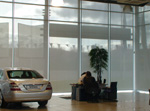Questions
How to order blinds?
Contact us and we can either make the blinds from your measurements or else we can call out to you and measure, show samples and answer questions. You can also arrange to meet an expert in our showroom. Price varies about 15 to 200 euro per blind depending on blind size and type or 400-1500 euro for advanced blinds.
If you wish to proceed, we will then contact you when the blinds are ready for collection or to arrange an appointment for fitting of the blinds by professional fitters, at a suitable time for you. We usually phone about two working days from date of order.
When fitting is complete, we accept many payment types including Visa, Mastercard, cash, electronic bank transfer, Apple Pay, Android Pay, wireless cards, Maestro, American Express, Diners Club, Discover, Union Pay, bank drafts, cheques, Revolut.
All blinds come with a minimum 2 year guarantee. Some blinds may have longer guarantees including electric 5 years, Velux 3 years, Verosol 3 years.
What specialist blinds are supplied?
We supply blinds for a very wide variety of requirements, including for homes, offices, manufacturers, hospitals and educational institutions.
If you have a particular type of blind you have in mind, please contact us and if we are unable to supply this blind, we will give you an alternative supplier.
Example blinds include:
- extremely large blinds
- fitting into shaped windows including curved, apex and triangular
- short-notice service including for large orders
- complete blackout
- blinds to keep temperature comfortable and free from glare
- logo blinds
- motorized blinds and connection to automation systems
What should be considered when choosing a blind?
Personal preference. Roller blinds and venetian blinds are popular in Ireland. Plain or subtle textures with light or mid-bright shades are popular.
View outside. Vertical blinds and venetian blinds have narrow openings through slats, while most other blinds such as rollers and pleated have one opening. Screen fabrics allow a view through the cloth while providing daytime privacy.
Room function. For example blackout blinds for bedroom or cinema room.
Safety. Cordless blinds such as motorised are safest. All our staff are trained in child safety. Heavy blinds should be fitted onto strong foundations. Plasterboard especially on a roof is less sturdy than mounting onto concrete, flint or metal frame.
Price. Roller and aluminium venetian blinds are lower cost. Blinds, such as roman blinds, are higher cost due to quantity, type or complexity of materials.
Glare control. Sun-reflective fabric such as Verosol has a metallic surface that prevents sunlight glare inside the building.
Automation. Blinds can be controlled by hand or by remote control or automatically such as depending on sunlight.
Privacy. For example during the daytime, blinds with screen fabric allow indoor privacy while retaining a view outside compared to venetian blinds will offer less privacy for the same view outside.
Interior design. For example romans or a heavy curtain that gathers on floor can complement a period home.
Tv% (Visual Light Transmittance) factor. This helps compare how much light will enter the room and takes into account fabric colour, thickness, weave density and coatings.
Fit. Usually blinds are fitted into the window recess. We also supply blinds specially made for tilt and turn windows that move with the window. Or fit outside the recess.
Energy use. For improved insulation, BER rating and cost savings, polyvinyl shutters help keep heat in while Verosol blinds, brise soleil and external blinds reduce excess solar heat gain.
Hygiene. In bathrooms, anti-mildew textiles will help preserve the blind appearance. Venetian blinds require regular cleaning because their surfaces face upwards so dust will land on the surface more regularly. Specialist anti-microbial blinds are ideal for hospitals
Availability. Most blinds can be fitted in less than 3 days. Some blinds may have longer waiting time such as pleated.
Outside appearance. For example, different color fabrics can be made to appear the same color from outside the building, for a uniform look.
Window orientation and size. North-facing windows may require less protection from glare and heat. Large untinted roof windows may require more protection
Health. For example Verosol fabrics are certified for non-toxic materials (Oeko-Tex standard 100) especially relevant if there is a fire. Verosol is formaldehyde and PVC free as well as flame retardant, compliant with IOS 140001 international environmental standard, and Greenguard certified
Sustainability and the environment. For example FSC-certified venetian blinds and natural textiles are more sustainable in the long term.
Acoustic absorption. For example shutters and acoustic fabrics will help with noise pollution from outside.
Operating conditions. Will the blinds be exposed to dust, air pollution, smoke, humidity? In the long run, these may affect functionality and appearance of some types of blinds, so choices need to be carefully considered
Ultraviolet light. UV light can fade furnishings and affect skin over time however blinds such as roller blinds with high-specification fabric will help stop UV light
Heat gain. Large glass areas can create very hot rooms during sunny weather however external blinds prevent heat entering or internal blinds using Verosol fabric can reflect heat back outside
Domestic or commercial. Commercial buildings will have more emphasis on productivity benefits of the blind and fabric selection
Quality. For example some fabrics may be unsuited to zip blinds or where heat levels change because the fabric may become stretched over time. Even though the fabric is cheaper at time of purchase, the overall cost of ownership is high if the blind does not function properly or begins to look ugly and needs replacing or fixing
Time of use. The times of day in which room will be occupied as well as how long people will stay there will determine if some factors are more important than others.
Marketing. For example a business logo can be put on a blind for advertising purpose.
Alternatives. Smartglass, eaves, awnings, brise soleil, frosted and tinted glass are alternatives or can compliment window blinds installation.
How can I keep blinds in good condition?
If vacuuming, use low-suction power with a soft brush attachment.
Rub dirt gently using a microfiber cloth with fabric cleaner spray. Test on an inconspicous area first. Be careful not to saturate, crush or wrinkle fabric. Allow blinds to dry in a ventilated, shaded area. A thorough clean after lengthy use or when badly soiled can be carried out by a specialist cleaning firm for example using ultrasonic cleaning.
Blinds should be kept away from excess moisture, smoke and deep-fat fryers unless designed for those conditions.
For all venetian blinds, when raising or lowering the slats it is best to keep the slats in the open position while supporting the weight of the slats with the other hand underneath the blind. Wood venetian slats may crack if bent, while aluminium venetians will crease.
For roller blinds with a spring, the blind should be raised and lowered by pulling the tassel straight down, not to the side. If the blind is difficult to raise, lower the blind and take the blind out of the brackets. Then roll the blind fabric up by hand and put the blind back into the brackets. Alternatively if the blind pulls to a close too fast, take blind out of the brackets and unroll the blind by hand before replacing the blind in the brackets.
For roller blinds with chain operation where the fabric is pulling to the side, put masking tape onto the tube on the opposite side of the blind.
Avoid using too much force when operating blinds. Avoid letting the blind drop in an uncontrolled way.
How to remove window blinds such as for painting a room?
For rollers with spring operation, lift the blind gently upwards along the path in the bracket.
On older roller blinds with a chain, on the end without the chain, pull the white clip at the nib before pulling the blind out. For newer roller blinds push the chain side up towards the ceiling then across to release the prongs.
For blinds with a headrail such as venetian or roman blinds, the covering of the rail usually detaches as it is held on by velcro. Then pull across the metal hinges holding the rail in place while supporting the rail to prevent it falling.
For vertical blinds, where the bracket is holding the rail just above there is a small screw to be loosened. On some rails without a screw, the rail can be unclipped out of the brackets.
For Verosol standard chain roller blind on one side, on the opposite side to the chain there is a circular movement mechanism that connects onto the bracket. Twist this downwards before sliding out that side first. For Verosol cassette blind or pleated, at the back of the blind where the bracket is holding the blind on, there is a very small lip. If you push the lip up with a screwdriver, the blind should release.